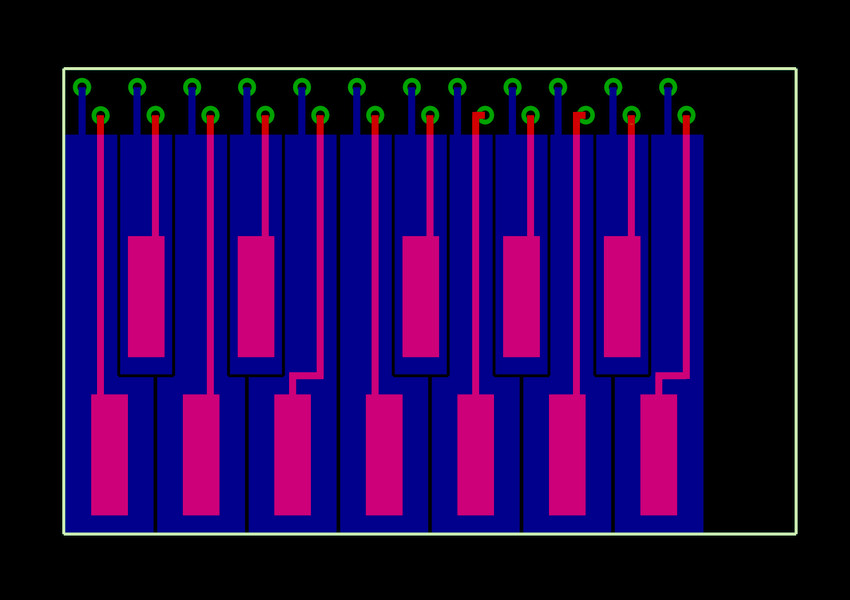| 96 kHz.org |
| Advanced Audio Recording |
|
Capacitive MIDI Keyboard for music applications A simple input keyboard for music purposes is presented here, which works according to a principle e.g. known from the switching functions of earlier televisions: Two plates of a capacitor are used to recognize the approach of a finger. Unlike the TV-switch, here the both caps are located on the sides of a common printed circuit board as it is used for electronic circuits. The keyboard consists of 2 opposite layers of the circuit board with specially adapted sizes for the sensor surfaces. By introducing signals into the plates and processing them with DSP-based signal algorithms afterwards, very small changes in the effective capacitance can be detected. In this way, the approaching of the finger to the board can be recognized. The type of noise and the signal processing play an important role here. The idea goes back to methods of the Institute for Metrology Engineering at my University (Institut für Regelungstechnik Universität Siegen). A special application to measure very tiny changes of a capacity was presented at the MessComp96 meeting and is available on demand. See "Hochaufgelöste Auswertung passiver Sensoren auf korrelativer Basis, MESSCOMP Wiesbaden 1996, K.W.Bonfig". In short words a noise signal is introduced into the capacitor, picked up by AD-conversion and later substracted from the original signal with adapted amplitudes. The debris is so to speak the signal to be used.
layout design
Print of the EAGLE Layout of the music PCB
the principal operation In this application, I tried various signals and ended up with a sum of dedicated frequencies that can be filtered in a good way. Practically a PLD-based noise generator based on a LFSR register in a Lattice ISP1016 generates the signal and passes it onto the capacitor plates via a Burr-Brown buffer. The current is measured using a two-wire technology and fed to an ADC via a differentially connected TI-OpAmp. The obtained noise signal is substracted from the introduced signal to get a comparison in order to determine a meaningful value for the current through the capacitor. In fact specific parts of the noise are emphasized. This already is observable due to the interference of the finger with the scattered electric field, so that the approximation becomes roughly visible. Later, even the pressure on the circuit board can be made visible. In addition, the position of the finger can even be slightly estimated when it moves between two keys.
Input circuit to process the signal of the PCB
calibrating the PCB As one can imagine, the PCB and the circuit must be calibrated, while the main problem is the PCB. The "white" keys produce a completely different signal than the "black" ones, which is probably due to the absorption of the scattering nosie by the neighbour keys and also the position of the finger. The signals also look different when the finger moves lengthwise over the key. The evaluation is not trivial, but it is always possible to recognize the movement of the finger and detect especially the "touch" when it stops moving - i.e. when it has obviously "hit" the button.
Foto of the noisy signal done with a Conrad 2010 oscilloscope
Conclusion and Summary Simple PCBs can be used to detect approaching objects like fingers and are suitable as inputs for MIDI devices when interlligent signal processing is used.
|
| © 2000 - Dipl.-Ing. Jürgen Schuhmacher |



